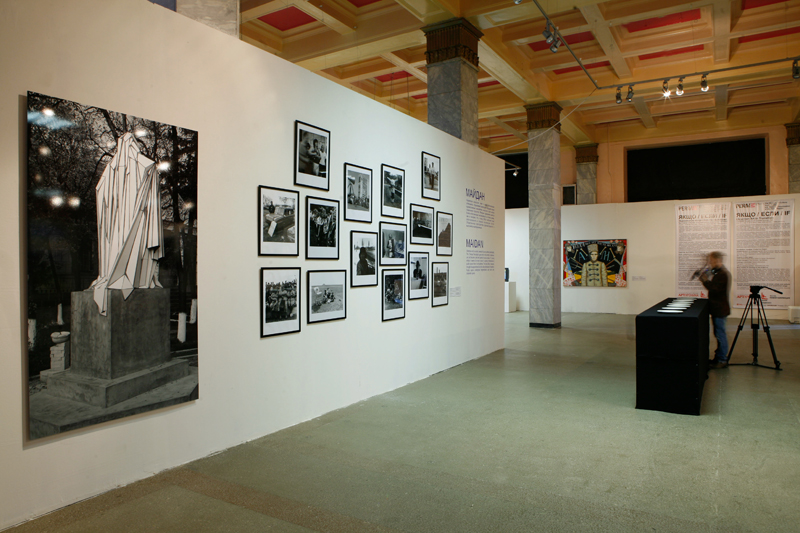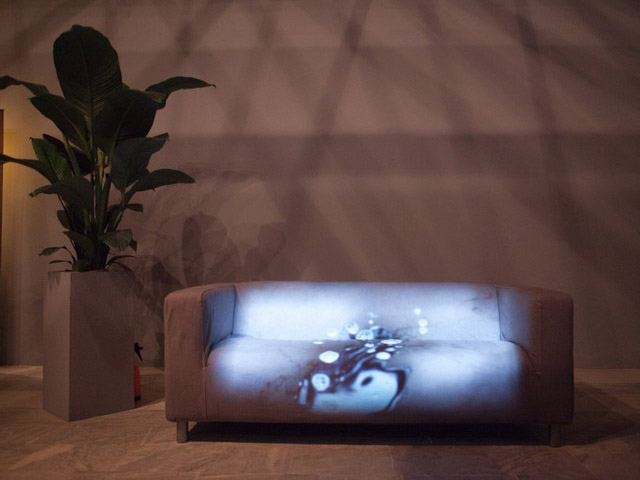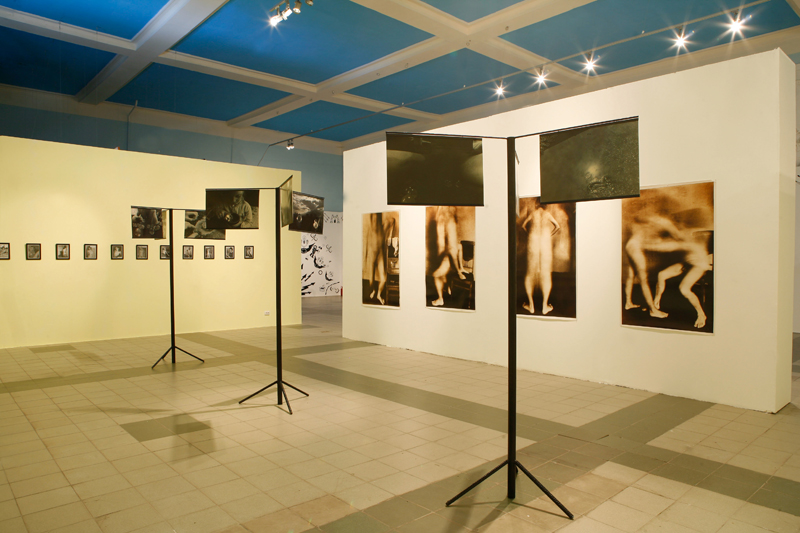“ЯКЩО / ЕСЛИ / IF”, PERMM Museum of Contemporary Art (Exhib. Review)
“???? / ???? / IF”, PERMM Museum of Contemporary Art, May 21 – July 10, 2010
The presentation of Ukrainian contemporary art in the exhibition ???? / ???? / IF at the PERMM Museum of Contemporary Art in Russia–the first such comprehensive display outside of Ukraine’s borders–appeared to be a political act. The initiative of the Moscow-based curator, Ekaterina Degot, raised immediate suspicions. How will a Russian curator, essentiallyan outsider, approach the task of showcasing Ukrainian art in her native country? How will the exhibition address the long and complicated shared history of the two neighboring countries? What are the implications of exhibiting Ukrainian contemporary art in a provincial Russian museum in the current climate of political uncertainty between Russia and Ukraine?
???? / ???? / IF was as complex as any work of art, and as open to a multitude of interpretations. Degot initially envisioned the exhibition as a showcase for paintings from the Ukrainian New Wave of the 1980s-1990s, but her investigations into the Ukrainian art scene led to a more diverse show, including various media and a broader generational representation of Ukrainian artists. IF sets out to represent the multiple vectors of artistic activity leading up to, and since, the 2005 Orange Revolution. It is thematically organized into four sections: “Maidan” (political art and art in public space), “Wonderland” (critical reflection on the idea of national identity), “Phantoms” (visionary painting), and “Dreamers” (socio-emotional background of Ukraine today). The second floor of the museum held three additional chapters of Ukrainian art which provided a conceptual base for the contemporary works displayed below: Marat Guelman’s foundational painting collection entitled “Histories”, Alexander Roytburd’s collection of naïve and conceptual art, as well as an overview of the Kharkiv school of photography. Overall, the exhibition features around 100 works by 30 artists.
 Upon entering the museum, one immediately confronts the installations by artists engaged in the social commentary of public space: “Maidan” and “Wonderland”. The artworks in “Maidan” demonstrate the inescapable interrelatedness of societal and personal life. Zhanna Kadyrova’s Monument to a New Monument (2006-2009) is a meditation on post-Soviet public space littered with monuments but without those that would reflect on the current national situation. Nikita Kadan’s Procedure Room (2009-2010) presents a series of dishes emblazoned with images of torture methods rumored to be practiced by the police, suggesting a relationship between hidden government policy and the individual human body. The R.E.P. group’s Super Sale (2008) addresses the massive migration of Ukrainian laborers to Poland. The works in the “Maidan” grouping employ common, everyday, objects: plates, graffiti, public monuments and television commercials reminiscent of Soviet social realism.
Upon entering the museum, one immediately confronts the installations by artists engaged in the social commentary of public space: “Maidan” and “Wonderland”. The artworks in “Maidan” demonstrate the inescapable interrelatedness of societal and personal life. Zhanna Kadyrova’s Monument to a New Monument (2006-2009) is a meditation on post-Soviet public space littered with monuments but without those that would reflect on the current national situation. Nikita Kadan’s Procedure Room (2009-2010) presents a series of dishes emblazoned with images of torture methods rumored to be practiced by the police, suggesting a relationship between hidden government policy and the individual human body. The R.E.P. group’s Super Sale (2008) addresses the massive migration of Ukrainian laborers to Poland. The works in the “Maidan” grouping employ common, everyday, objects: plates, graffiti, public monuments and television commercials reminiscent of Soviet social realism.
The works grouped under the title “Wonderland” explore the role of ornament and visual symbolism in shaping contemporary Ukrainian culture, both at the local and the global levels. Volodymyr Kuznetsov laconically fuses the traditional symbol of Ukrainian folk culture with a sign of the Ukrainian elite in VIP-Car (2007): an old BMW decorated with a floral embroidery pattern inscribed with bullet-holes. Roman Minin paints miners in various settings: at work in the coal mines, standing next to rap stars, and praying to a modern icon of the Virgin Mary. While the artist sees miners as universal figures digging for the meaning of life, his images are particularly relevant for the PERMM audience because this region, like Minin’s native Donbass, is heavily engaged in coal-mining. Western Ukrainian Igor Pereklita’s I am a Bandera Girl, I am a Ukrainian Girl! (2007) combines visual techniques used in propaganda posters and religious icons, depicting a woman in a traditionally embroidered blouse holding a rifle and a hand grenade. Her blouse carries the slogan: “Death to the Muscovite Occupants.” The painting, which becomes especially provocative when displayed in Russia, also presents a different, though equally relevant, side of Ukrainian identity politics. The diversity of images and technical approaches to the works in “Wonderland” echo the cacophony of forces, ideologies and stereotypes underlying the unstable Ukrainian national identity.
In the large gallery, the separation between “Maidan” and “Wonderland” is vague, for the thematic issues of public space, national identity and socio-political mechanisms that affect the individual are all intertwined. Together, the two sections present Ukraine’s public image, one of political chaos and perpetual reconstruction of national identity as it appears from the outside. The adjacent galleries present the more introspective, personal suffering of two generations of Ukrainian contemporary artists. And yet, even in the private meditations of these artists, the overarching structure of being a Ukrainian citizen permeates each work.
 “Phantoms” consists primarily of paintings and photographs of the founding generation of Ukranian contemporary art, including the late Olexander Gnylytsky, Arsen Savadov, Vassily Tsagalov, Andrii Sagaidakovsky, Ilya Chichkan. Personal reflections on everyday life in Ukraine–already somewhat absurd–are slightly distorted by each artist’s individual approach. Gnylytsky painted objects like chairs and curtains with a deep, haunting sensitivity to color, bestowing metaphysical significance to mundane artifacts of the Soviet and post-Soviet domestic landscape. An installation by the Institution of Unstable Thoughts (Gnylytsky and Lesya Zayats) called Media Comfort (2006) reproduces a room with a sofa, a lamp and a plate that are used as screens for projected images whose trance-inducing rhythm disrupts any initial expectation of stability that may have been raised by by the mundane nature of the room.
“Phantoms” consists primarily of paintings and photographs of the founding generation of Ukranian contemporary art, including the late Olexander Gnylytsky, Arsen Savadov, Vassily Tsagalov, Andrii Sagaidakovsky, Ilya Chichkan. Personal reflections on everyday life in Ukraine–already somewhat absurd–are slightly distorted by each artist’s individual approach. Gnylytsky painted objects like chairs and curtains with a deep, haunting sensitivity to color, bestowing metaphysical significance to mundane artifacts of the Soviet and post-Soviet domestic landscape. An installation by the Institution of Unstable Thoughts (Gnylytsky and Lesya Zayats) called Media Comfort (2006) reproduces a room with a sofa, a lamp and a plate that are used as screens for projected images whose trance-inducing rhythm disrupts any initial expectation of stability that may have been raised by by the mundane nature of the room.
 In contrast with the surreal, painterly images presented in “Phantoms”–imbuing scenes of everyday life with fantasy–, the younger artists in the “Dreamers” section use photography, video, and objects that trace the history of unfulfilled dreams of wealth, security, the freedom to travel, and worldwide recognition. Alevtina Kakhidze’s documentation of her arduous attempt to obtain a visa to visit a friend in Australia entitled Invitation to Australia, or The Museum of One History,2002; SOSKA’s Dreamers (2008); a collection of images showing teenagers masked by the universal uniform of emo subculture; and Sergey Bratkokv’s photographs of women holding sperm from a reproductive clinic called Princesses (1996) all use everyday objects to suggest that young Ukrainians, who are all too aware of their compromised political and social standing in the world, still have the power to dream.
In contrast with the surreal, painterly images presented in “Phantoms”–imbuing scenes of everyday life with fantasy–, the younger artists in the “Dreamers” section use photography, video, and objects that trace the history of unfulfilled dreams of wealth, security, the freedom to travel, and worldwide recognition. Alevtina Kakhidze’s documentation of her arduous attempt to obtain a visa to visit a friend in Australia entitled Invitation to Australia, or The Museum of One History,2002; SOSKA’s Dreamers (2008); a collection of images showing teenagers masked by the universal uniform of emo subculture; and Sergey Bratkokv’s photographs of women holding sperm from a reproductive clinic called Princesses (1996) all use everyday objects to suggest that young Ukrainians, who are all too aware of their compromised political and social standing in the world, still have the power to dream.
 The “Histories” section, enriched by interviews with three collectors featured in the exhibition catalogue, offers broad narrative insight into the development of the contemporary Ukrainian art scene. This development took place with little support or intrusion from institutions (Ukrainian, Soviet or otherwise), and the exchange of education and information occurred on an interpersonal level, mostly through personal experimentation and communication. To illustrate this grassroots activity, Degot highlights the artistic community in Kherson, represented by maverick artist Stas Volyazlovsky; and the “Totem” Studio” that produces multi-media works and local festivals far from Ukraine’s more celebrated cultural centers (Kyiv, Kharkiv, Odessa, Lviv). Valentin Diakonov of the Russian Kommersant newspaper has speculated that, in contrast to Russia, the under-developed art institutions in Ukraine do give artists the freedom to experiment with different media and different approaches without seeking an affiliation with any particular school or institution, and that this results in a uniquely Ukrainian product.
The “Histories” section, enriched by interviews with three collectors featured in the exhibition catalogue, offers broad narrative insight into the development of the contemporary Ukrainian art scene. This development took place with little support or intrusion from institutions (Ukrainian, Soviet or otherwise), and the exchange of education and information occurred on an interpersonal level, mostly through personal experimentation and communication. To illustrate this grassroots activity, Degot highlights the artistic community in Kherson, represented by maverick artist Stas Volyazlovsky; and the “Totem” Studio” that produces multi-media works and local festivals far from Ukraine’s more celebrated cultural centers (Kyiv, Kharkiv, Odessa, Lviv). Valentin Diakonov of the Russian Kommersant newspaper has speculated that, in contrast to Russia, the under-developed art institutions in Ukraine do give artists the freedom to experiment with different media and different approaches without seeking an affiliation with any particular school or institution, and that this results in a uniquely Ukrainian product.
In spite of–or because of–the curator’s position as an outsider, IF genuinely represented the Ukrainian contemporary art scene in all its contradictions and self-doubt. Through all the thematic sections one can trace the strong connection between the artist’s personal vision and the underlying national situation. According to Degot, the exhibition is really about Ukraine as a nation. IF presents a picture of instability at the level of both daily existence and, more broadly speaking, on the level of national politics and identity. The artworks suggest that equilibrium is only possible in a moment of instability. Degot sees the instability of Ukraine’s political situation, especially in its relation to Russia, as fruitful for art production.
The curator’s introductory text establishes her intention of using IF as a lens though which to reflect on contemporary Russia. Local visitors were forced to confront their own stereotypes about Ukrainian culture. Many visitors were surprised by the melancholic dream-images, and some were offended by the more aggressive artistic reflections on Ukraine’s marginalization in regard to the rest of the world. Some visitors saw the Ukrainian artists as representative of their own distinct political and cultural climate, while others discovered that they shared some of the same concerns represented in the exhibition.
When I visited the exhibition in June, the people I spoke to–affiliated with the Museum–were excited about Ukrainian contemporary art. They showed me the traces left in public spaces by artists like Minin and Hamlet Zinkovsky. They recalled with delight Alevtina Kakhidze’s presentation of The Most Commercial Project Ever (2008) in a local fashion boutique. In contrast to a pervasive sentiment in Ukraine, also present in the art world, that desires an outside authority to come and show us how it’s done, to take care of us and bring us into union with either Europe or Russia, IF testifies to the fact that art can be born in any kind of atmosphere. The artists in the show do not fall back on excuses such as “if we had more institutional support, funding from the government, a vibrant art market, more up-to-date education, then…” Instead these artists work within the given situation, producing art that genuinely represents its context, and thus has the potential to change it.






